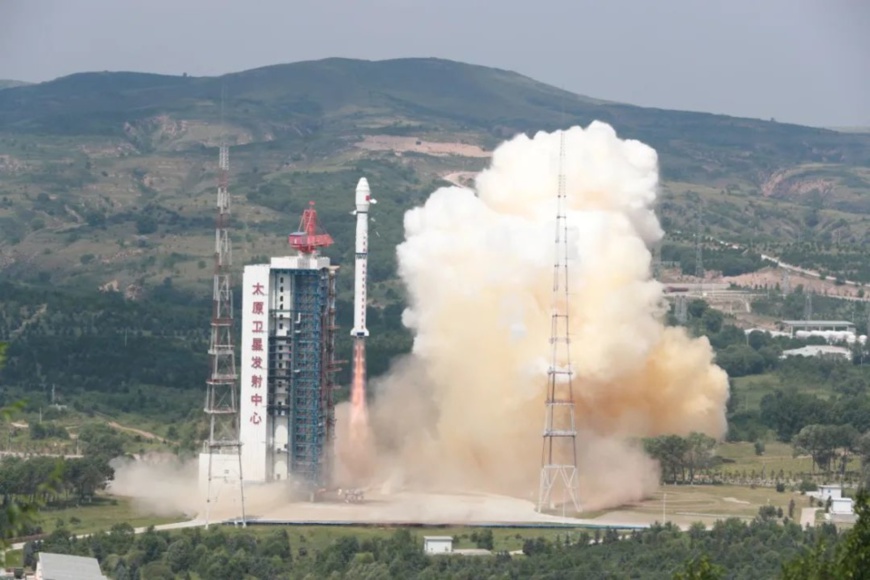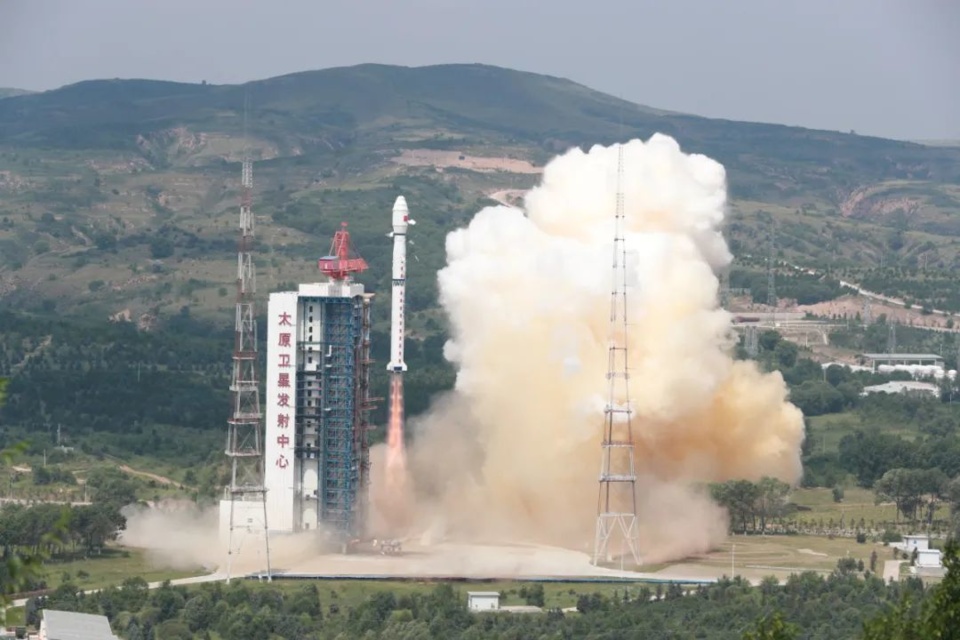By Feng Hua, Zhang Wei, People’s Daily

A terrestrial ecosystem carbon monitoring satellite, named “Goumang,” is sent into orbit from the Taiyuan Satellite Launch Center in north China’s Shanxi Province. (China National Space Administration/Zheng Taotao)
China recently successfully launched a terrestrial ecosystem carbon monitoring satellite from the Taiyuan Satellite Launch Center in north China’s Shanxi Province.
Named “Goumang,” the satellite is expected to provide remote sensing services and improve the efficiency and accuracy of carbon sink measurement, providing important support for the country’s efforts to peak carbon dioxide emissions before 2030 and achieve carbon neutrality before 2060.
As a scientific research satellite under the framework of China’s medium and long-term development plan of national civilian space infrastructure, Goumang will operate in a sun-synchronous orbit at an altitude of 506 kilometers, inclined 97.4 degrees, according to Cao Haiyi, chief designer of Goumang.
The satellite is able to detect and measure such factors as vegetation biomass, atmospheric aerosol and chlorophyll fluorescence through comprehensive remote sensing means, including laser, multi-angle, multi-spectral, hyperspectral, and polarization.
The satellite can provide a wide variety of services, such as monitoring carbon in the terrestrial ecosystem, surveying and monitoring terrestrial ecology and resources, monitoring and evaluating major environmental protection projects, monitoring the atmospheric environment, and obtaining data about the effect of aerosols on climate change.
Moreover, the satellite will also meet the needs for the determination of vertical control points, disaster monitoring and evaluation, and agricultural forecasting. It will significantly boost quantitative land remote sensing in China.
The satellite can obtain information about global forest carbon sinks through both active and passive remote sensing. This will help enhance the country’s capability to monitor and measure carbon sinks in various ecosystems, including forests, grasslands, wetlands and desertified land.
Equipped with payloads including laser radar, multi-angle and multi-spectral camera, hyperspectral detector and polarization imager, Goumang can monitor key data on carbon sink capacity of forests, including plant height, vegetation coverage, chlorophyll fluorescence, and PM2.5 concentrations, helping improve the efficiency and accuracy of carbon sink measurement.
The multi-beam laser radar enables the satellite to measure the height of a tree by calculating the difference between the time when the laser beams scan the crown of the tree and the time when the laser beams scan the ground.
Through statistical analysis and application tests, the research and development (R&D) team has managed to use five laser devices on the radar to emit laser beams 200 times in one second, eventually shortening the distance between two objects to be monitored from several thousand meters to several hundred meters and significantly improving the accuracy of plant height measurement.
The satellite has five multi-spectral cameras, which can help monitor the Earth from five angles. This enables the satellite to accurately measure vegetation coverage and the density of forests. The five multi-spectral cameras can help the satellite create a three-dimensional map with high accuracy of the distribution of vegetation in the area monitored by the satellite.
The satellite’s ability to accurately map the distribution of chlorophyll fluorescence offers important support for the efficient and precise measurement of carbon sinks. To improve the accuracy of detecting the spectrum of chlorophyll fluorescence, which emits only a very small amount of energy, a hyperspectral detector has been installed in the satellite and the theory of grating spectrometer has been applied, which increased the spectral resolution by tenfold, enabling the device to detect even the most subtle change in daylight intensity.
In order to remove the atmospheric effects, a polarization imager has been installed on the satellite, which is able to detect PM2.5 concentrations from 35 angles and obtain information about horizontal PM2.5 concentrations.
In addition, the satellite is also equipped with a laser radar, which can help monitor longitudinal PM2.5 concentrations. These two payloads enable the satellite to provide information about PM2.5 concentrations from three dimensions, guaranteeing a higher level of accuracy for atmospheric correction.
The launch of Goumang marked the 430th mission of the Long March rocket family. Also launched on the same rocket were two small satellites, namely the Jiaotong 4 and the Minhang Youth.
The Jiaotong 4 will be used to collect information about ship movements and flight statuses around the globe, as well as information about the global Internet of Things (IoT). The Minhang Youth, which is designated as a platform for young students to partake in space science research and engineering practice activities, including satellite design, satellite R&D, satellite payloads, and satellite launch, will carry out applied scientific research on space-Earth integrated carbon source monitoring.
Named “Goumang,” the satellite is expected to provide remote sensing services and improve the efficiency and accuracy of carbon sink measurement, providing important support for the country’s efforts to peak carbon dioxide emissions before 2030 and achieve carbon neutrality before 2060.
As a scientific research satellite under the framework of China’s medium and long-term development plan of national civilian space infrastructure, Goumang will operate in a sun-synchronous orbit at an altitude of 506 kilometers, inclined 97.4 degrees, according to Cao Haiyi, chief designer of Goumang.
The satellite is able to detect and measure such factors as vegetation biomass, atmospheric aerosol and chlorophyll fluorescence through comprehensive remote sensing means, including laser, multi-angle, multi-spectral, hyperspectral, and polarization.
The satellite can provide a wide variety of services, such as monitoring carbon in the terrestrial ecosystem, surveying and monitoring terrestrial ecology and resources, monitoring and evaluating major environmental protection projects, monitoring the atmospheric environment, and obtaining data about the effect of aerosols on climate change.
Moreover, the satellite will also meet the needs for the determination of vertical control points, disaster monitoring and evaluation, and agricultural forecasting. It will significantly boost quantitative land remote sensing in China.
The satellite can obtain information about global forest carbon sinks through both active and passive remote sensing. This will help enhance the country’s capability to monitor and measure carbon sinks in various ecosystems, including forests, grasslands, wetlands and desertified land.
Equipped with payloads including laser radar, multi-angle and multi-spectral camera, hyperspectral detector and polarization imager, Goumang can monitor key data on carbon sink capacity of forests, including plant height, vegetation coverage, chlorophyll fluorescence, and PM2.5 concentrations, helping improve the efficiency and accuracy of carbon sink measurement.
The multi-beam laser radar enables the satellite to measure the height of a tree by calculating the difference between the time when the laser beams scan the crown of the tree and the time when the laser beams scan the ground.
Through statistical analysis and application tests, the research and development (R&D) team has managed to use five laser devices on the radar to emit laser beams 200 times in one second, eventually shortening the distance between two objects to be monitored from several thousand meters to several hundred meters and significantly improving the accuracy of plant height measurement.
The satellite has five multi-spectral cameras, which can help monitor the Earth from five angles. This enables the satellite to accurately measure vegetation coverage and the density of forests. The five multi-spectral cameras can help the satellite create a three-dimensional map with high accuracy of the distribution of vegetation in the area monitored by the satellite.
The satellite’s ability to accurately map the distribution of chlorophyll fluorescence offers important support for the efficient and precise measurement of carbon sinks. To improve the accuracy of detecting the spectrum of chlorophyll fluorescence, which emits only a very small amount of energy, a hyperspectral detector has been installed in the satellite and the theory of grating spectrometer has been applied, which increased the spectral resolution by tenfold, enabling the device to detect even the most subtle change in daylight intensity.
In order to remove the atmospheric effects, a polarization imager has been installed on the satellite, which is able to detect PM2.5 concentrations from 35 angles and obtain information about horizontal PM2.5 concentrations.
In addition, the satellite is also equipped with a laser radar, which can help monitor longitudinal PM2.5 concentrations. These two payloads enable the satellite to provide information about PM2.5 concentrations from three dimensions, guaranteeing a higher level of accuracy for atmospheric correction.
The launch of Goumang marked the 430th mission of the Long March rocket family. Also launched on the same rocket were two small satellites, namely the Jiaotong 4 and the Minhang Youth.
The Jiaotong 4 will be used to collect information about ship movements and flight statuses around the globe, as well as information about the global Internet of Things (IoT). The Minhang Youth, which is designated as a platform for young students to partake in space science research and engineering practice activities, including satellite design, satellite R&D, satellite payloads, and satellite launch, will carry out applied scientific research on space-Earth integrated carbon source monitoring.
 Menu
Menu
 China launches first terrestrial ecosystem carbon monitoring satellite
China launches first terrestrial ecosystem carbon monitoring satellite
















